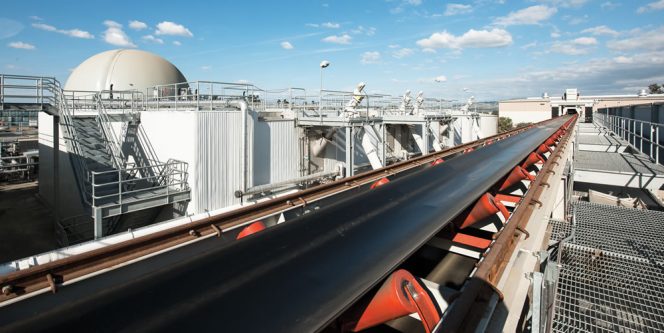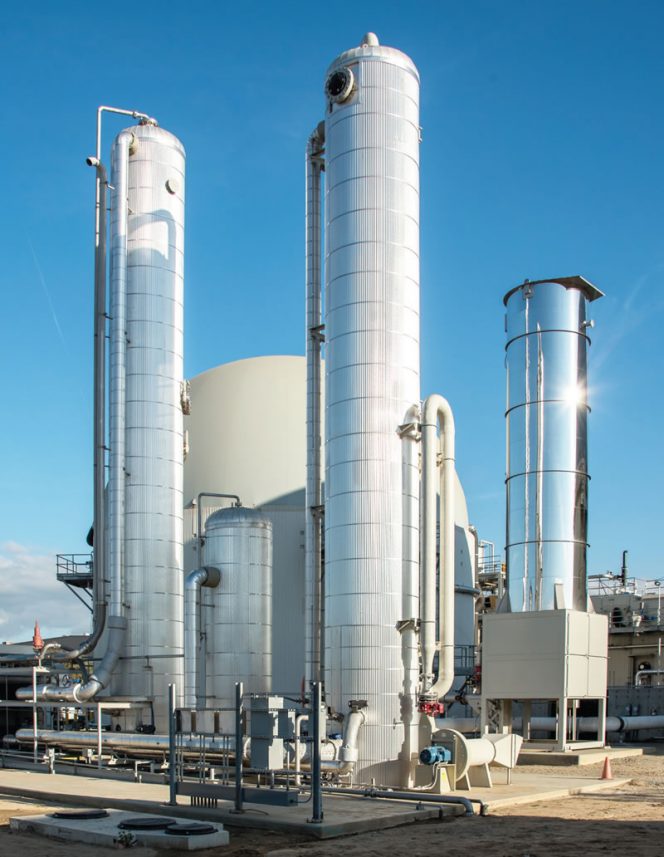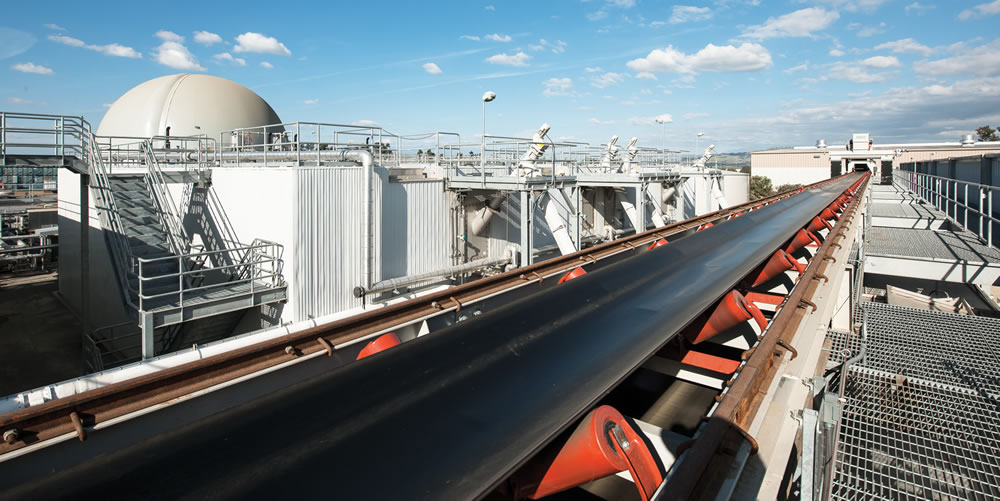Southern California waste management company opens high solids anaerobic digestion facility to process municipal yard trimmings and food waste.
Nora Goldstein
BioCycle May 2017
A ten year process that included finding the right technology, plant design and construction, has culminated in operation of a high solids anaerobic digester in Perris, California that processes residential yard trimmings and a small quantity of residential food waste. The facility, owned and operated by CR&R Environmental Services, a southern California waste management company, is being developed in four phases; each phase is designed to process 83,600 tons/year.
When BioCycle visited in January, Phase I was in commissioning, and Phase II was well under construction. Not all of the equipment was installed in the organics receiving and preprocessing building, and construction of a pipeline (about 1.4 miles long) to bring renewable natural gas from the AD facility to the Southern California Gas Company (SoCalGas) distribution system was just getting underway. As of April 1, the organics receiving facility is fully operational and the SoCalGas pipeline construction is nearly complete.

An automated smart conveyor delivers feedstock from the organics recovery facility to fill “hoppers” that feed the digesters. Photo courtesy of CR&R Environmental Services
Primary feedstocks are source separated residential green waste and small amounts of food waste that are cocollected with the green waste. The facility is designed to eventually accept a variety of organic feedstocks, including solid and liquid food waste streams from the commercial and industrial sectors. “We selected the Eisenmann high solids AD technology because it can effectively manage green waste,” notes Paul Relis, Senior Vice President of CR&R. “This system is tailored to serve the organics recycling needs of our cities. Eisenmann’s completely self-enclosed and automated system, and its advanced process knowledge suited our urban setting and our operating philosophy.”
Design And Operation
The degree to which the AD plant is automated is impressive. After initial processing, a walking floor conveyor carries the organics up to an elevated automated feeding device that transports materials from the receiving building, overhead into infeed hoppers, which have capacity to store 2 to 3 days worth of feedstock. Walking floors in the hoppers, which are built on top of scales, move the feedstocks toward an auger that loads the digester. The quantity of feedstock to meter in and the amount of liquid to add to the feedstock prior to loading the digester are controlled by a computer program.
At the time of our visit, ground residential yard trimmings mixed with small amounts of residential food scraps were being put directly onto the conveyor that goes to the automated feeding device with a front-end loader. The preprocessing line, which started operating in April, includes: a 160-foot long walking floor conveyor that brings materials to a sorting platform where up to 8 sorters remove contaminants; an overhead magnet and eddy current separator to pull out ferrous and nonferrous metals; an electric powered grinder that size reduces the feedstock to under 2 inches; and a trommel screen equipped with an air lift separator. The organics receiving building and equipment are sized to accommodate the full build out of the AD facility.
The plant has a 106,000-gallon liquid receiving tank. Four rectangular digesters are currently operating. Each digester is equipped with a 103-foot long center auger mixer that runs 24/7 at about 1 RPM. “The AD plant is a hybrid system that can take liquids and solids simultaneously,” explains Michael Silva, Project Manager at CR&R. “The average solids content going into the digesters is 40 to 50 percent. The Eisenmann system is both plug flow and mixed, with an average retention time of 21 days. It operates continuously at a thermophilic temperature of about 130°F.”
After 21 days, the digestate goes through a screw press to separate the solids and liquids. The screw press also runs 24/7. The liquids go into a secondary 650,000-gallon “post digester” for 7 to 10 days, to capture additional biogas. The Phase I AD facility is capable of producing 10 million gallons/year of liquids and 35,000 tons/year of solids. Each phase includes four main digesters and one post digester.

The AD Plant utilizes the Greenlane Biogas water wash gas upgrading technology. This system is sized for 2 phases of the 4-phase build-out, and is capable of generating up to 2 million diesel gallon equivalents of RNG
per year. Photo courtesy of CR&R Environmental Services
Biogas To Vehicle Fuel
CR&R installed a Greenlane water scrubbing and vacuum pressure swing adsorption (VPSA) system to condition the biogas, which is about 50 percent methane and 50 percent carbon dioxide. The pressure in the water column pushes the CO2 into solution; the VPSA has small tanks containing different media to remove nitrogen, oxygen and other constituents to yield a renewable natural gas (RNG) with 98 to 99 percent methane. “Once the 1.4 mile pipeline from the AD facility to the SoCalGas pipeline is complete, we expect to deliver 2 million cubic feet/day,” notes Silva. CR&R’s cost for the pipeline interconnection is close to $7 million. When the interconnect is completed, CR&R is eligible for an up to $3 million rebate administered by SoCalGas. It also has received funding from the California Energy Commission ($4.52 million) and the South Coast Air Quality Management District (total of $1.4 million for Phases I and II) to offset these costs. CR&R will be receiving $3 million from CalRecycle for construction of the Phase II AD system.
The company is using the RNG — which is expected to have a California Air Resources Board (CARB) registered carbon intensity value of negative 23, as compared to diesel, which is 95 — to fuel its waste collection fleet. It currently has 75 vehicles domiciled at its Perris facility with compressed natural gas (CNG) engines. “Once we are in the pipeline we can wheel RNG to our other natural gas fueling stations notes,” Clarke Pauley, Vice President, Organics & Biogas Division at CR&R. “We slow fill the trucks overnight when it is cooler and the gas doesn’t expand. The trucks hold about 40 gasoline gallon equivalents of RNG fuel.” At the full Phase IV build out, the company will produce enough RNG to fuel about 320 vehicles.
Once the connection to the SoCalGas line is complete, all conditioned RNG will be injected into the pipeline, and then pulled back out again to fuel the trucks. Completion of the line and interconnection is anticipated by this summer. CR&R must meet SoCalGas’ specs on oxygen, nitrogen, methane and hydrogen sulfide. “We can monitor all of that from the control room,” says Silva.
CR&R is in the registration process to sell its renewable fuel carbon credits, federal Renewable Fuel Standard RINs, and State of California Low Carbon Fuel Standard (LCFS) credits. “We will have our RINs ‘QAP’ qualified by a third party verifier which adds to their value,” he adds. “We will sell our LCFS credits to obligated parties — petroleum companies and marketers of petroleum products.”
End Products, Next Steps
CR&R is developing markets for the digestate products. The digested solids look similar to a green waste compost, but are slightly higher in moisture. The outputs meet pathogen reduction requirements. “We are testing application of the solids on farms,” explains Pauley. “The liquids have about 6 to 10 percent solids, and we are testing application on rye grass, sudan, sorghum and alfalfa. CR&R is applying for organic certification through the Organic Materials Review Institute for both our solid and liquid products. Our soil products will also meet the American Biogas Council (ABC) Digestate Standard specifications.”
Phase II construction is expected to be done by mid-2017, at which point the facility will have capacity to process about 165,000 tons/year of source separated organics. Pauley anticipates that between 60 and 70 percent of the product output will be solids, with the remainder being liquids. “We can determine that ratio — 60:40 or 70:30 of solids to liquids — by adjustments to the screw press,” he says.
Building out the rest of the plant will depend on how many municipalities CR&R can contract with for organics collection and processing. It has contracts with 11 cities, and is in negotiations with several more that should come on line within a few months. “We have enough feedstock within our collection system for at least three phases,” notes Relis.










